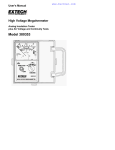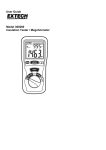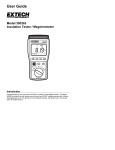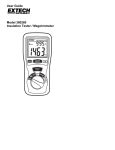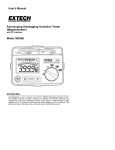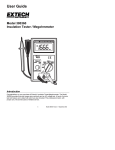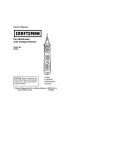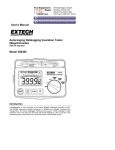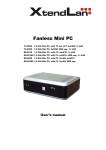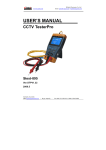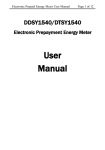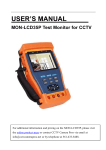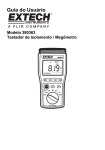Download User`s Manual Low Voltage Megohmmeter Model 380350
Transcript
User's Manual Low Voltage Megohmmeter Analog Insulation Tester plus AC Voltage and Continuity Tests Model 380350 Introduction Congratulations on your purchase of Extech’s Low Voltage Megohmmeter. This meter is geared toward low voltage insulation testing applications such as Information Technologies and Telecommunications. In addition to Megohmmeter (Insulation Resistance) measurements, low Resistance and AC Voltage can be measured. This professional meter, with proper care, will provide years of safe reliable service. Safety 1. 2. 3. 4. 5. 6. Circuits under test must be de-energized and isolated before connections are made (except for voltage measurements). Circuit connections must not be touched during a test. Use extreme caution when working near bare conductors and bus bars. Accidental contact with conductor could result in electrical shock. Use caution when working near voltages above 60VDC or 30VACrms. After insulation tests, capacitors must be discharged. Test leads (including alligator clips) must be in good working order, clean and without broken or cracked insulation. When servicing, use only specified replacement parts. International Safety Symbols Caution, refer to this manual before using this meter Dangerous Voltages Meter is protected throughout by double or reinforced insulation Rated Environmental Conditions • Indoor use only • Installation Category III • Pollution degree 2 • Altitude up to 2000 meters • Ambient conditions: Temperature: 32 to 104oF (0 to 40oC); RH: 80% max. 2 380350 V1.4 11/2003 Specifications General specifications Display Insulation test ranges AC Voltage test Low Resistance Live circuit indicator Withstand voltage Power source Power consumption Fuse protection Operating conditions Dimensions Weight Taut band multi-scale analog display with Power Test and Live Circuit status LEDs and zero screw adjust 20/50/100MΩ (50V/125V/250V) tests 600VAC measurements (40 to 1kHz) 0 to 50Ω LED lights when live circuit is sensed Meets IEC-1010 safety requirements for Cat. III 600V Eight 1.5 AA cells included Megohmmeter: 160mA max.; Continuity: 120 mA max. 250V (1A) for Insulation Resistance and Continuity Tests 32 to 104oF (0 to 40oC); < 80% RH 6.7 x 6.5 x 3.6” (170 x 165 x 92mm) 2.1 lbs (970g) Range Specifications Low Resistance Range Max. open circuit Volt 600mV (240mA) 0 to 50Ω Accuracy Overload Protect. 250Vrms ±5% of scale length AC Voltage Range 600VAC Accuracy ±2.5% of full scale Line Frequency 40 to 1kHz Insulation Resistance / Megohmmeter Range 0 to 20MΩ (50VDC ±10%) 0 to 50MΩ (125VDC ±10%) 0 to 100MΩ (250VDC ±10%) Accurac y ±5% of reading 3 Short circuit current 2mA 380350 Overload Protection 250Vrms V1.4 11/2003 Meter Description 1. 2. 3. 4. 5. 6. 7. 8. 9. 10. Analog Display Live Circuit status LED Pointer zero adjustment screw Power Test status LED TEST pushbutton with Lock function Function select switch Battery compartment on rear Test lead EARTH input jack Test lead LINE input jack Test lead storage compartment Analog Scale Description 1. 125V / 50MΩ Megohmmeter Scale (multiply reading by 2 for 250V / 100MΩ range) 2. 50V / 20MΩ Megohmmeter Scale 3. 4. Low Resistance Scale (0 to 50Ω) AC Voltage Measurement Scale (0 to 600V) There are two Scales for the Megohmmeter (Insulation Resistance) measurements. The top scale (No.1 in diagram) is used for the 125V / 50MΩ range. This same top scale is also used for the 250V / 100MΩ range but the user must multiply the reading by 2. Scale No. 2 in the diagram is used for the 50V/20MΩ range only. Scale No. 3 in the diagram is used for low resistance measurements. Scale No. 4 is used for AC voltage measurements. 4 380350 V1.4 11/2003 Operation Measurement Precautions Refer to the earlier Safety section for detail safety information. Always connect the meter leads to the circuit under test before pressing the TEST button. Do not touch the clip ends of the test leads when the TEST button is pressed. Some electrical equipment, especially cables, may retain an electrical charge when disconnected from the line. It is good practice to discharge such equipment with grounding straps, or other suitable devices, before testing. The meter automatically discharges the test circuits when the spring loaded TEST button is released. Connecting Test Leads For all functions (Megohmmeter, Low Resistance, and AC Voltage), connect the red test lead to the LINE terminal and the black lead to the EARTH terminal. Mechanical Zero Adjust Insert the test leads into the meter and short the free ends of the test leads. Set the function switch to the ohms position and push the TEST button to the test position. Carefully adjust the mechanical zero screw for a zero ohms reading. Test Lead Check Set the rotary switch to the low resistance position (Ω). Connect the leads to the meter and short the clip ends of the test leads and read the green resistance scale on the display. The resistance should read between 0 and 0.5Ω. The display should read maximum range with the leads open (not shorted). If any readings are obtained other than the readings just described, the test leads should be considered faulty and must be replaced before using the meter. Failure to do so could result in damage to equipment and electrical shock. Insulation Resistance / Megohmmeter Testing (50V/20MΩ 125V/50MΩ 250V/100MΩ) Connect the red test lead to the LINE input jack and connect the black test lead to the EARTH input jack. Connect the other ends of the test leads to the device under test. Turn the rotary switch to the desired range and press and hold down the TEST button. To lock the TEST button down, turn the TEST button to the right after pressing it down. The resistance reading will display until the TEST button is released. To interpret the Insulation Resistance reading on the Analog display scale refer to the previous section entitled Analog Scales Description. Note on large installations: In large wiring installations where the insulation of outlets is being tested, more than one measurement may have to be made to take into account parallel resistances. Divide large systems into subgroups and test subgroups individually. Also, in large installations, the capacitance of the insulation will be high thereby taking longer to charge when being tested. Care must be taken not to finish a measurement until the insulation capacitance is fully charged (a steady, stable reading is an indication that this is the case). The charge stored in the insulation after a test will be discharged automatically when the test button is released. Be careful not to turn the range switch while the test button is pressed. 5 380350 V1.4 11/2003 Live Circuit Status LED If the Live Circuit status LED is lit, voltage is present on the device under test. DO NOT proceed to test with voltage present. Shock to the user and damage to the meter or device under test can result if testing is done with voltage present. Proceed with testing only when the voltage is removed from the device under test. Power Test Status LED When the meter is actively testing, the Power Test status LED will blink. When this status LED is flashing DO NOT touch the test leads or any exposed parts in the testing area. Hazardous voltages exist that can cause shock. If the Power Test LED fails to light, the batteries must be replaced. Refer to the Maintenance section near the end of this manual. Low Resistance Tests WARNING: Do not run this test unless the voltage on the device under test is zero. Do not use this mode to check diodes or other semiconductor devices. If the Live Circuit status LED lights when a test is initiated, immediately abort the test and check that the circuit under test is not powered. 1. Set the Function select switch to the Resistance (Ω) position. 2. Connect the red test lead to the LINE input and the black lead to the EARTH input. 3. Perform a zero adjustment using the zero adjust screw on the display as described earlier. 4. Connect the other ends of the test leads to the circuit under test and read the resistance on the green display scale. The maximum resistance is 50Ω. AC Voltage Tests 1. Set the Function select switch to the red ACV 600V position. 2. Connect the red test lead to the LINE input and the black test lead to EARTH. 3. Connect the other end of the test leads IN PARALLEL to the circuit under test. 4. Read the voltage value on the red display scale. 6 380350 V1.4 11/2003 Maintenance Battery Replacement If the red Power Test status LED no longer lights when a test is initiated, the eight 1.5 V AA batteries must be replaced. 1. Ensure that the meter is not in the test mode and that the test leads aren't connected. 2. Remove the phillips head screw on the rear battery compartment cover. 3. Remove the battery compartment cover. 4. Replace the eight AA batteries ensuring proper polarity. 5. Affix the rear cover, and secure the rear screw. Fuse Replacements To test for an open fuse first assure that the batteries are not defective and then proceed as follows: 1. Connect the test leads to the meter and short the clip ends of the test leads. 2. Set the function switch to the ohms position and press the TEST button. 3. If the fuse is open (blown), the pointer will indicate an open circuit (max resistance). 4. To locate the fuse, open the rear battery/fuse compartment via the Phillips head screw located at the center of the meter case. 5. Replace the fuse (250V, 1A fast acting) located in the battery/fuse compartment just above the batteries to the right. Secure the battery/fuse cover. Cleaning Periodically wipe the case with a dry cloth. Do not use solvents or abrasives. Do not allow water to seep into the meter case. 7 380350 V1.4 11/2003 Calibration and Repair Services Extech offers repair and calibration services for the products we sell. Extech also provides NIST certification for most products. Call the Customer Service Department for information on calibration services available for this product. Extech recommends that annual calibrations be performed to verify meter performance and accuracy. Warranty EXTECH INSTRUMENTS CORPORATION warrants this instrument to be free of defects in parts and workmanship for one year from date of shipment (a six month limited warranty applies on sensors and cables). If it should become necessary to return the instrument for service during or beyond the warranty period, contact the Customer Service Department at (781) 890-7440 ext. 210 for authorization or visit our website at www.extech.com (click on ‘Contact Extech’ and go to ‘Service Department’ to request an RA number). A Return Authorization (RA) number must be issued before any product is returned to Extech. The sender is responsible for shipping charges, freight, insurance and proper packaging to prevent damage in transit. This warranty does not apply to defects resulting from action of the user such as misuse, improper wiring, operation outside of specification, improper maintenance or repair, or unauthorized modification. Extech specifically disclaims any implied warranties or merchantability or fitness for a specific purpose and will not be liable for any direct, indirect, incidental or consequential damages. Extech's total liability is limited to repair or replacement of the product. The warranty set forth above is inclusive and no other warranty, whether written or oral, is expressed or implied. Support Hotline (781) 890-7440 Tech support: Ext. 200; Email: [email protected] Repair/Returns: Ext. 210; Email: [email protected] Website: www.extech.com Copyright © 2003 Extech Instruments Corporation All rights reserved including the right of reproduction in whole or in part in any form. 8 380350 V1.4 11/2003








